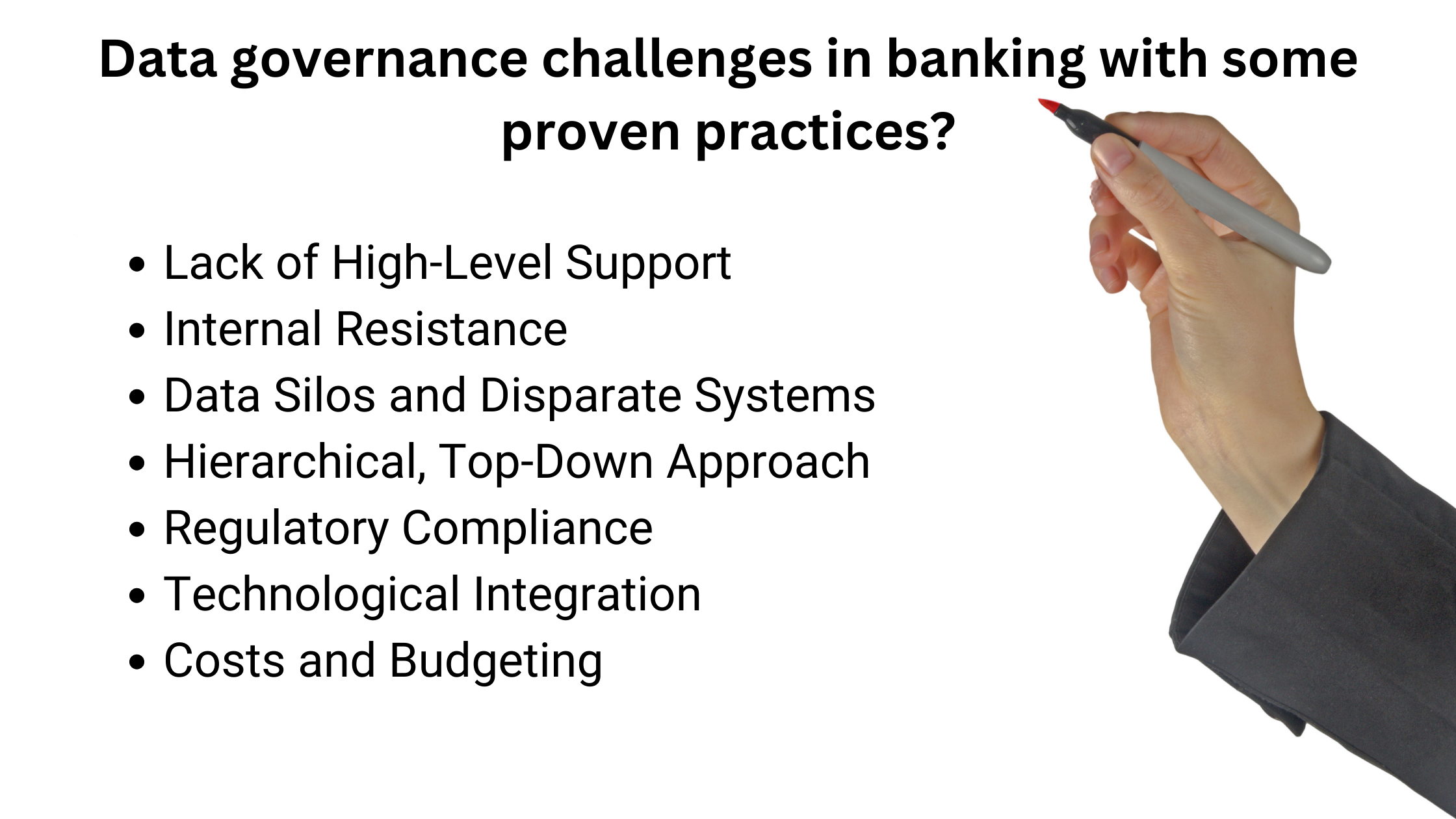
Introduction
In banking, where every transaction and decision depends on data, controlling how we handle that data is critical. Hence, data governance in banking is an essential aspect of focus.
Data governance in banking means handling financial data responsibly. It involves creating processes, rules, and controls to keep data accurate and secure.
This article explores the benefits, implementation strategies, challenges, and proven practices that will allow you to master data governance, which is essential for the success of modern banking.
Let’s get started!
So, how does data governance transform banking outcomes, and is it beneficial?
- Navigating Regulatory Compliance and Risk Management:
This refers to strict adherence to regulatory standards and protocols without complications. It ensures a seamless alignment with established guidelines.
- Elevating Operational Efficiency:
It translates to optimizing operational processes, enhancing efficiency, and creating an environment where tasks are executed seamlessly for improved productivity.
- Enhancing Customer Experience and Satisfaction:
This denotes a commitment to providing exceptional service, meeting customer expectations, and ensuring overall satisfaction, thus fostering customer loyalty and positive relationships.
- Fueling Innovation and Competitive Advantage:
It signifies cultivating an atmosphere conducive to innovation, where creative thinking is encouraged, generating novel and valuable concepts.
- Driving Revenue Growth and Profitability:
This points towards implementing strategies that steadily increase revenue, ensuring sustained profitability and financial growth.
Data governance is crucial in regulatory adherence, operational excellence, customer satisfaction, innovation, and financial success within the banking sector. It ensures that data is utilized optimally to drive positive and transformative outcomes.

But how do you implement data governance in banking effectively?
Did you know without data governance, banks would not be able to comply with major regulations? They could face fines, lose sanctions, or even revocation of their licenses. Hence, effectively implementing data governance in banking is crucial.
Here is a strategic roadmap encompassing various steps to implement data governance in banking:
- Setting Clear Goals and Objectives:
Define what you want to achieve with data governance. Clearly outline your goals and objectives, aligning them with the overall vision of the bank.
- Conducting a Comprehensive Data Inventory Assessment:
Take stock of your bank’s data. Understand its scope, quality, and relevance. This assessment lays the foundation for effective data governance.
- Identifying Data Domains, Owners, and Consumers:
Categorize data into specific domains, assign ownership to responsible parties, and identify those using the data. Ensuring accountability and clarity in data management.
- Defining Data Governance Roles and Responsibilities:
Clearly articulate the roles and responsibilities of individuals involved in data governance. Defining the duties of data stewards, custodians, and other key personnel.
- Constructing a Solid Data Governance Framework:
Develop a robust framework outlining the processes, policies, and controls governing data management. This framework acts as a guide for everyone involved in handling data.
- Implementing Data Governance Tools and Technologies:
Utilize appropriate tools and technologies to facilitate efficient data governance. These may include data quality tools, metadata management systems, and other relevant technologies.
- Measuring Framework Adoption and Effectiveness:
Regularly assess how well the data governance framework is being adopted. Evaluate its effectiveness in achieving the defined goals and make adjustments as needed.
- Establishing a Training and Continuous Education Program:
Ensure that personnel involved in data governance are well-equipped. Provide training programs and continuous education to update them on best practices and emerging trends.
- Monitoring and Measuring Progress:
Implement monitoring mechanisms to track the progress of data governance initiatives. Regularly measure key performance indicators to gauge the effectiveness of your efforts.
- Fostering a Data-Driven Culture:
Cultivate a culture where data is valued and leveraged in decision-making. Encourage a mindset where everyone recognizes the importance of responsible and effective data management.
By following this roadmap, banks can ensure that data is treated as a valuable asset and managed in a way that aligns with organizational goals and industry best practices. However, implementing data governance in banking has its challenges. Let’s explore some common hurdles and how proven practices can overcome them.
How do we solve data governance challenges in banking with some proven practices?

- Lack of High-Level Support
Challenge: When leadership doesn’t prioritize data governance, implementation faces resistance.
Proven Practice: Securing Executive Buy-In – Actively involve top management, demonstrating the tangible benefits of data governance in achieving organizational goals.
- Internal Resistance
Challenge: Employees may resist changes to established workflows.
Proven Practice: Starting with High-Impact, Low-Effort Initiatives – Begin with manageable projects that showcase immediate positive outcomes, easing the transition.
- Data Silos and Disparate Systems
Challenge: Data scattered across various systems make governance complex.
Proven Practice: Mapping All Data Domains and Sources – Identify and document all data sources, promoting a holistic view that aids effective governance.
- Hierarchical, Top-Down Approach
Challenge: A rigid top-down approach may stifle collaboration and innovation.
Proven Practice: Bottom-Up Data Governance Framework – Involve employees at all levels in shaping governance processes fostering a collaborative environment.
- Regulatory Compliance
Challenge: Navigating complex and evolving regulations can be daunting.
Proven Practice: Adapt Evolving Data Privacy Regulations – Establish a dedicated team to monitor and adapt to changing regulatory landscapes, ensuring ongoing compliance.
- Technological Integration
Challenge: Integrating new technologies can be a challenge.
Proven Practice: Tools & Partners that Support Active Data Governance – Invest in tools aligning with governance goals and collaborate with tech partners to understand the banking data landscape.
- Costs and Budgeting
Challenge: Budget constraints may hinder effective implementation.
Proven Practice: Careful Planning and Allocation – Develop a detailed budget, prioritizing critical aspects and ensuring a phased, cost-effective rollout.
Addressing these challenges with proven practices ensures a smoother implementation of data governance in banking, creating a foundation for efficient data management and maximizing its benefits.
Got more questions? Consult Datacrew.ai
Datacrew.ai provides end-to-end services across various areas of the data value chain, such as business intelligence, data engineering, data science, and data visualization.
Datacrew.ai can help banks with data governance in banking by:
Building scalable and secure data pipelines that collect, transform, and store data from various sources, such as transactions, customer interactions, and market trends.
Developing and deploying data-driven solutions that leverage advanced analytics, machine learning, and artificial intelligence to generate insights, predictions, and recommendations for business decisions and customer engagement.
Creating and maintaining data quality standards, policies, and procedures that ensure data accuracy, completeness, and consistency across the organization.
Implementing and monitoring data security and privacy measures that protect sensitive data and comply with regulatory requirements and industry best practices.
For more information, book a free consultation on our website Datacrew.ai, today!